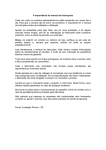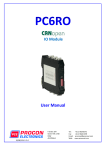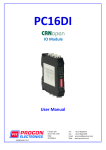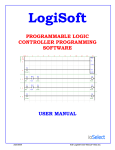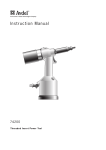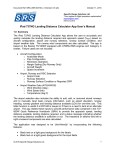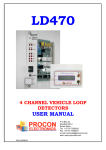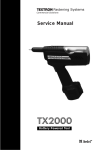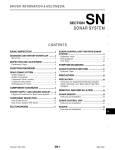Download programmable logic controller with inductive loop detector user
Transcript
PL400 PROGRAMMABLE LOGIC CONTROLLER WITH INDUCTIVE LOOP DETECTOR USER MANUAL P.O.Box 24 STANFIELD 3613 SOUTH AFRICA 29/06/2004 V01 Tel: Fax: Email: Web: +27 (031) 7028033 +27 (031) 7028041 [email protected] www.proconel.com TABLE OF CONTENTS 1. AN OVERVIEW OF THE PL400 PROGRAMMABLE LOGIC CONTROLLER......................... 3 1.1 DESCRIPTION ........................................................................................................................ 3 2. PL400 GENERAL INFORMATION ............................................................................................... 4 2.1 PHYSICAL DIMENSIONS ..................................................................................................... 4 2.2 GROUNDING/SHIELDING.................................................................................................... 4 3. PL400 HARDWARE ....................................................................................................................... 5 3.1 SPECIFICATIONS .................................................................................................................. 5 3.2 WIRING TERMINALS ........................................................................................................... 5 3.3 FRONT PANEL DESCRIPTION. ........................................................................................... 6 4. CONFIGURATION ......................................................................................................................... 7 4.1 HARDWARE CONNECTIONS. ............................................................................................. 7 4.1.1 Connecting the Power....................................................................................................... 7 4.1.2 Connecting the Inputs. ...................................................................................................... 7 4.1.3 Connecting the Outputs. ................................................................................................... 8 4.1.4 Connecting the Inductive Loop......................................................................................... 8 4.1.5 Connecting the programming port to a PC. ...................................................................... 9 4.2 PL400 CPU............................................................................................................................. 10 4.2.1 Program Memory............................................................................................................ 10 4.2.2 Data Memory.................................................................................................................. 10 4.2.3 Data Memory Map.......................................................................................................... 11 4.2.4 Digital Input Map. .......................................................................................................... 12 4.2.5 Digital Output Map......................................................................................................... 12 4.2.6 Timer Map. .....................................................................................................................13 4.2.7 Counter Map. .................................................................................................................. 13 4.2.8 Control Relay Map. ........................................................................................................ 14 4.2.9 System Relay Map.......................................................................................................... 14 5. Inductive Loop Detector................................................................................................................. 15 5.1 Using the Loop Detector......................................................................................................... 15 5.2 Configuring the Loop Detector............................................................................................... 15 5.3 Loop Installation Guide. ......................................................................................................... 16 6. Modbus Memory Map ( MODULE TYPE = 40) ........................................................................... 17 7. Ladder Logic Function Blocks ....................................................................................................... 19 PROCON ELECTRONICS 2 PL400 Programmable Logic Controller 1. AN OVERVIEW OF THE PL400 PROGRAMMABLE LOGIC CONTROLLER 1.1 DESCRIPTION The PL400 PLC has been developed as a versatile controller for use in parking or access control applications. The PLC can be used to operate gates or barriers where an inductive loop detector is required to sense the presence of vehicles. The fact that the controller is programmable enables the user to program their own unique logic requirements and not be restricted by a pre-programmed unit. The PL400 PLC is programmed in ladder logic. PROCON’s PROSOFT windows-based PC software is used to generate the ladder diagram, compile the program, and then download the program to the PL400 via the programming port on the front of the unit. The I/O consists of 8 digital inputs and 4 relay outputs. The inputs are opto-isolated and a built in field supply is used to power the inputs so no external power supply is required. The PLC has a user programmable toggle switch on the front, which can be incorporated into the ladder program as manual inputs. Two led’s are also provided for user functions. All wiring is done with screw terminals on removable connectors. The programming port requires the use of a special adaptor to connect it to an RS232 communications port of a PC. This port supports the Modbus RTU protocol and all of the internal registers and I/O status can be accessed through this port. PROCON ELECTRONICS 3 PL400 Programmable Logic Controller 2. PL400 GENERAL INFORMATION 2.1 PHYSICAL DIMENSIONS The PL400 enclosure is shown below. The module has been designed with a quick snap-in assembly for mounting onto DIN-rail’s as per DIN EN 50 022. 46.00 mm 106 mm 60.00 mm 59.50 mm 70.00 mm 2.2 GROUNDING/SHIELDING In most cases, the PL400 will be installed in an enclosure along with other devices, which generate electromagnetic radiation. Examples of these devices are relays and contactors, transformers, motor controllers etc. This electromagnetic radiation can induce electrical noise into both power and signal lines, as well as direct radiation into the module causing negative effects on the system. Appropriate grounding, shielding and other protective steps should be taken at the installation stage to prevent these effects. These protective steps include control cabinet grounding, module grounding, cable shield grounding, protective elements for electromagnetic switching devices, correct wiring as well as consideration of cable types and their cross sections. PROCON ELECTRONICS 4 PL400 Programmable Logic Controller 3. PL400 HARDWARE 3.1 SPECIFICATIONS POWER REQUIREMENT: 200 - 260VAC 50/60Hz. 8 X INPUTS: These inputs may be activated by a potential free relay contact or open collector NPN transistor output. These inputs are isolated from the logic. 4 X OUTPUTS: These outputs are a normally open relay contact rated at 6A/220VAC (resistive). INDICATORS: LED indicators show power, user1, user2 and programming communications. LOOP RESPONSE TIME: Approximately 120ms after vehicle enters loop. DETECTOR TUNING RANGE: 15 - 1500 uH. LOOP PROTECTION: Loop isolation transformer with lightning protection. CONNECTORS: 2 X 12 Way Removable Connectors with screw terminals. DIMENSIONS: 106mm (HIGH) X 70mm (WIDE) X 59.5mm (DEEP) OPERATING TEMPERATURE: -20°C to +60°C STORAGE TEMPERATURE: -20°C to +65°C HUMIDITY: up to 95% non condensing 3.2 WIRING TERMINALS 24 – Earth 12 – 220VAC Neutral 23 – Loop Detector 11– 220VAC Live 22 – Loop Detector 10 – Relay 1 N/C 21 – Input Common 9 – Relay 1 Common 20 – Input 8 8 – Relay 1 N/O 19 – Input 7 7 – Relay 2 N/O 18 – Input 6 6 – Relay 2 Common 17 – Input 5 5 – Relay 3 N/O 16 – Input 4 4 – Relay 3 Common 15 – Input 3 3 – Relay 4 N/O 14 – Input 2 2 – Relay 4 Common 13 – Input 1 1 – Relay 4 N/C Pl400 PROCON ELECTRONICS 5 PL400 Programmable Logic Controller 3.3 FRONT PANEL DESCRIPTION. The led's on the front panel of the PL400 Module are used to indicate power, and user defined LED1 and LED2. A programming LED is used to indicate communications with a PC during programming and Debugging. A toggle switch is provided which allows you to use this in your application, for as an example, a manual override switch. Power LED User LED2 Programming Port LED User LED1 Programming Port User Two Way toggle switch PROCON ELECTRONICS 6 PL400 Programmable Logic Controller 4. CONFIGURATION 4.1 HARDWARE CONNECTIONS. 4.1.1 Connecting the Power. Power must be applied to terminal 11 (220VAC LIVE) and terminal 12 (220VAC NEUTRAL). When the power is initially applied the power LED will illuminate and all other LED's will be off. 12 – 220VAC Neutral 11– 220VAC Live As the PLC is often used to control machinery, which could present a risk of personal injury or damage to equipment, it is good practice to wire an external emergency stop circuit to the power supply on the PLC. The circuit below shows how a mechanical contactor (MC) is used with start/stop buttons to provide this facility. Circuit Breaker MC Emergency Stop Power Supply 220VAC 50/60Hz Supply to PL400 and Output Circuits Start MC MC MC 4.1.2 Connecting the Inputs. The inputs are sourced from an internally isolated power supply and can be switched by a potential free contact or a NPN transistor. The inputs all share the common terminal. 21 – Input Common 20 – Input 8 19 – Input 7 18 – Input 6 17 – Input 5 16 – Input 4 15 – Input 3 14 – Input 2 13 – Input 1 PROCON ELECTRONICS 7 PL400 Programmable Logic Controller 4.1.3 Connecting the Outputs. The outputs are potential free relay contacts. Note that only Relay output 1 and 4 have normally closed contacts as well as normally open contacts. 10 – Relay 1 N/C 9 – Relay 1 Common 8 – Relay 1 N/O 7 – Relay 2 N/O 6 – Relay 2 Common 5 – Relay 3 N/O 4 – Relay 3 Common 3 – Relay 4 N/O 2 – Relay 4 Common 1 – Relay 4 N/C The outputs may be used to control the direction of a motor. For example output 1 could be used to control the forward direction of the motor and output 2 used to control the reverse direction. It could be possible under fault conditions that both outputs switch on at the same time. It is considered good practice to interlock the two outputs both in the ladder program and using external mechanical contactors. The diagram below shows how this is done. O1 MC 2 MC 1 PL400 Outputs O2 MC 1 MC 2 4.1.4 Connecting the Inductive Loop. Refer to the chapter further in the manual on installing the inductive loop. The diagram below shows how to connect the loop to the PL400. 24 – Earth LOOP TWISTED 23 – Loop Detector 22 – Loop Detector CABLE PROCON ELECTRONICS 8 PL400 Programmable Logic Controller 4.1.5 Connecting the programming port to a PC. The PL400 programming port is connected to a RS232 communications port on the PC using a special programming cable supplied by Procon. The RS232 connector is a DB-9 plug which plugs into the PC. PROCON ELECTRONICS 9 PL400 Programmable Logic Controller 4.2 PL400 CPU. The CPU (central Processing Unit) performs all of the tasks that are required to make the PLC function and run your ladder program. Some of the tasks include: 1. 2. 3. 4. 5. 6. Reading the status of the inputs. Executing the program. Updating the outputs. Doing diagnostics. Servicing the communications ports. Running the timers. 4.2.1 Program Memory. The programming port is used to program the PLC. The program which is sent from the PC using the ProSoft ladder editor, is stored in FLASH memory. This memory does not get lost when the power fails and so will remain permanently in the PLC until it is reprogrammed. 4.2.2 Data Memory. All the variables used in the program are stored in Data memory. Both the Digital and Analog values are stored in this memory along with the timers, counters, and user memory. The memory is divided up into 3 sections. 1. RAM – Random Access Memory. This memory is the most widely used memory and is where most of the data is stored. All timers, counters, I/O statuses and system information use this memory. If the power fails then all the information in this memory is lost and is re-initialized to zero when the PLC starts again. 2. EEPROM – This memory is used to store parameters such as set-points and configuration data as it retains its memory when the power is turned off. The one point to remember is that this memory can only be written to 10 000 times before it wears out so you must not write to this memory all the time as you can with RAM. 3. BBRAM (Optional extra) – This is battery backed RAM and also retains its memory when the power is switched off. This memory is slow compared to RAM and should not be used where normal RAM can be used. This memory is ideal for storing values such as used in counting applications. The Real time clock is also stored in this memory. PL400 0 RAM 113 EEPROM 153 BBRAM (Option) 172 PROCON ELECTRONICS 10 PL400 Programmable Logic Controller 4.2.3 Data Memory Map. All of the variables used in the PLC are stored in data memory. In order for your program to get access to these variables you need to know the memory address. The memory address starts at zero and the size depends on the PLC being used. Each memory location consists of 16 bits. Thus one memory location can be used to store the status of 16 digital I/O points or an analog value from 0 to 65535. Some of the ladder functions use two consecutive memory locations to store larger values. Refer to the ProSoft user manual to find out about the ladder functions. PL400 MEMORY MAP Memory Type Module Type = 40 Digital Inputs Digital Outputs Timer Status Counter Status Control Relays System Relays Timer Memory Counter Memory User RAMMemory User EEPROM User BBRAM Digital Reference I1 to I14 O1 to O6 T1 to T16 C1 to C16 R1 to R64 S1 to S32 PROCON ELECTRONICS Memory Address M0 M1 M2 M3 M4 M5 – M8 M9 – M10 M13 – M28 M29 – M44 M45 – M112 M113 – M152 M153 – M172 - 11 Quantity 1 14 6 16 16 64 32 16 16 68 40 20 PL400 Programmable Logic Controller 4.2.4 Digital Input Map. MSB 15 14 - 13 I14 12 I13 11 I12 10 I11 Bit Number 0 1 2 3 4 5 6 7 8 9 10 11 12 13 14 15 PL400 DIGITAL INPUTS 9 8 7 6 5 4 I10 I9 I8 I7 I6 I5 Digital Input Number I1 I2 I3 I4 I5 I6 I7 I8 I9 I10 I11 I12 I13 I14 - 3 I4 2 I3 1 I2 LSB 0 I1 ADDRESS LSB 0 O1 ADDRESS M1 Description Digital Input 1 Digital Input 2 Digital Input 3 Digital Input 4 Digital Input 5 Digital Input 6 Digital Input 7 Digital Input 8 Toggle Switch 1 Toggle Switch 2 Loop Detect Loop Pulse Loop Detect LED Loop Fault LED - 4.2.5 Digital Output Map. MSB 15 14 - 13 - 12 - 11 - 10 - Bit Number 0 1 2 3 4 5 6 7 8 9 10 11 12 13 14 15 PROCON ELECTRONICS PL400 DIGITAL OUTPUTS 9 8 7 6 5 4 O6 O5 Digital Input Number O1 O2 O3 O4 O5 O6 - 12 3 O4 2 O3 1 O2 M2 Description Relay Output 1 Relay Output 2 Relay Output 3 Relay Output 4 LED 1 LED 2 - PL400 Programmable Logic Controller 4.2.6 Timer Map. MSB 15 14 T16 T15 13 T14 12 T13 11 T12 10 T11 Bit Number 0 1 2 3 4 5 6 7 8 9 10 11 12 13 14 15 PL400 TIMER STATUS 9 8 7 6 5 T10 T9 T8 T7 T6 4 T5 Digital Input Number T1 T2 T3 T4 T5 T6 T7 T8 T9 T10 T11 T12 T13 T14 T15 T16 3 T4 2 T3 1 T2 LSB 0 T1 ADDRESS M3 Description Timer 1 Timer 2 Timer 3 Timer 4 Timer 5 Timer 6 Timer 7 Timer 8 Timer 9 Timer 10 Timer 11 Timer 12 Timer 13 Timer 14 Timer 15 Timer 16 4.2.7 Counter Map. MSB 15 14 C16 C15 13 C14 12 C13 11 C12 PL400 COUNTER STATUS 10 9 8 7 6 5 C11 C10 C9 C8 C7 C6 Bit Number 0 1 2 3 4 5 6 7 8 9 10 11 12 13 14 15 PROCON ELECTRONICS Digital Input Number C1 C2 C3 C4 C5 C6 C7 C8 C9 C10 C11 C12 C13 C14 C15 C16 13 4 C5 3 C4 2 C3 1 C2 LSB 0 C1 ADDRESS M4 Description Counter 1 Counter 2 Counter 3 Counter 4 Counter 5 Counter 6 Counter 7 Counter 8 Counter 9 Counter 10 Counter 11 Counter 12 Counter 13 Counter 14 Counter 15 Counter 16 PL400 Programmable Logic Controller 4.2.8 Control Relay Map. MSB 15 R16 R32 R48 R64 14 R15 R31 R47 R63 13 R14 R30 R46 R62 12 R13 R29 R45 R61 11 R12 R28 R44 R60 10 R11 R27 R43 R59 PL400 CONTROL RELAYS 9 8 7 6 5 R10 R9 R8 R7 R6 R26 R25 R24 R23 R22 R42 R41 R40 R39 R38 R58 R57 R56 R55 R54 4 R5 R21 R37 R53 3 R4 R20 R36 R52 2 R3 R19 R35 R51 1 R2 R18 R34 R50 LSB 0 R1 R17 R33 R49 ADDRESS M5 M6 M7 M8 4.2.9 System Relay Map. MSB 15 14 S16 S15 S32 S31 13 S14 S30 12 S13 S29 11 S12 S28 Bit Number 0 1 2 3 4 5 6 7 8 9 10 11 12 13 14 15 10 S11 S27 PL400 SYSTEM RELAYS 9 8 7 6 5 S10 S9 S8 S7 S6 S26 S25 S24 S23 S22 Digital Input Number S1 S2 S3 S4 S5 S6 S7 S8 S9 S10 S11 - PROCON ELECTRONICS 14 4 S5 S21 3 S4 S20 2 S3 S19 LSB 1 0 S2 S1 S18 S17 ADDRESS M9 M10 Description ON 1st Scan 0.1 Second Clock Period 1 Second Clock Period 1 Minute Clock Period CMP < MEM/K CMP = MEM/K CMP > MEM/K PLC Running PLC Re-Program Request PLC Re-Program Acknowledge - PL400 Programmable Logic Controller 5. Inductive Loop Detector 5.1 Using the Loop Detector. The inductive loop detector is used to detect the presence of vehicles and can be used as a safety device, for arming or giving a pulse to operate the logic or may be used for counting. The inputs I11 to I14 are used to get information from the loop detector. Loop Detect Loop Pulse Loop Detect LED Loop Fault LED I11 I12 I13 I14 I11 – This bit is on when a vehicle is over the loop (in detect) and is off when there is no vehicle present. I12 – This bit is on for a short period of time to give a pulse output when the vehicle either enters (goes into detect) or leaves the loop (goes out of detect). The mode register is used to configure the pulse type and the pulse time register is used to configure the duration of the pulse. I13 – If the loop detect is in detect then this bit is on. This bit will toggle when the power is first applied to the PL400. The number of toggles indicates the loop frequency. You can use your ladder program to read in this bit and output it to an LED. I14 – If there is a fault on the loop then this bit will come on. It is automatically turned off when the fault is cleared and the detector has retuned. 5.2 Configuring the Loop Detector. The parameters, which are used to configure the loop detector, are stored in the first section of the user EEPROM. These parameters must be setup in your ladder program or in the debug menu when you are running the ProSoft ladder software. They do not get lost when the unit is powered off and so you only have to do the configuration once. M113 M114 M115 M116 M117 M118 Detect Sensitivity Detect UnSens Detect On Filter Detect Of Filter Pulse Time Pulse Mode PROCON ELECTRONICS X0.01%. - 2(0.02%) to 500(5%) X0.01%. - 2(0.02%) to 500(5%) X 10milliseconds. X 10milliseconds. X 10milliseconds. 0=puls on det, 1=puls on undet. 15 PL400 Programmable Logic Controller M113 - Detect Sensitivity: The sensitivity determines the detect level of the loop. The smaller the value the higher the sensitivity. The value can be from 2 to 500 and is multiplied by 0.01%. Some typical values are shown below. Value in M113 2 0.02% 5 0.05% 10 0.1% 100 1.0% M114 - Undetect Sensitivity: The undetect sensitivity determines the level at which the detector decides that the vehicle has left the loop. The smaller the value the higher the sensitivity. The value can be from 2 to 500 and is multiplied by 0.01%. This value must always be less that the value in M113 and is usually about a half of the value in M113. M115 – The Detect On Filter is a delay on detect and is usually used to prevent the detector for giving false detect outputs. A minimum value of 10 is good for normal use but higher values can be used. M116 – The Detect Off Filter is a delay on undetect and is usually used to extend the detect output after the vehicle has left the loop. A minimum value of 2 is good for normal use but higher values can be used. M117 – This value determines the pulse duration for the pulse bit. M118 – The pulse mode is used to select pulse on detect or pulse on undetect. 5.3 Loop Installation Guide. 1. The loop and feeder should be made from insulated copper wire with a minimum crosssectional area of 1.5mm2. The feeder should be twisted with at least 20 turns per metre. Joints in the wire are not recommended and must be soldered and made waterproof. Faulty joints could lead to incorrect operation of the detector. Feeders which may pick up electrical noise should use screened cable, with the screen earthed at the detector. 2. The loop should be either square or rectangular in shape with a minimum distance of 1 metre between opposite sides. Normally 3 turns of wire are used in the loop. Large loops with a circumference of greater than 10 metres should use 2 turns while small loops with a circumference of less than 6 metres should use 4 turns. When two loops are used in close proximity to each other it is recommended that 3 turns are used in one and 4 turns in the other to prevent cross-talk. 3. Cross-talk is a term used to describe the interference between two adjacent loops. To avoid incorrect operation of the detector, the loops should be at least 2 metres apart and on different frequency settings. 4. For loop installation, slots should be cut in the road using a masonry cutting tool. A 45o cut should be made across the corners to prevent damage to the wire on the corners. The slot should be about 4mm wide and 30mm to 50mm deep. Remember to extend the slot from one of the corners to the road-side to accommodate the feeder. 5. Best results are obtained when a single length of wire is used with no joints. This may be achieved by running the wire from the detector to the loop, around the loop for 3 turns and then back to the detector. The feeder portion of the wire is then twisted. Remember that twisting the feeder will shorten its length, so ensure a long enough feeder wire is used. 6. After the loop and feeder wires have been placed in the slot, the slot is filled with an epoxy compound or bitumen filler. TRAFFIC 300mm DIRECTION 300mm 1M 45O CROSSCUT PROCON ELECTRONICS ROAD SURFACE SLOT SEALANT ROAD EDGE 30-50 mm WIRES 4mm FEEDER 16 PL400 Programmable Logic Controller 6. Modbus Memory Map ( MODULE TYPE = 40) The data in the PL400 is stored in registers. These registers are accessed over the network using the MODBUS RTU communication protocol. There are 4 types of variables which can be accessed from the module. Each module has one or more of these data variables. Type Start Address Variable 1 2 3 4 00001 10001 30001 40001 Digital Outputs Digital Inputs Input registers (Analog) Output registers (Analog) Modbus Address Mem Addr 10017 “ 10032 00033 “ 00048 00049 “ 00064 00065 “ 00080 00081 “ 00144 00145 “ 00176 1.1 “ 1.16 2.1 “ 2.16 3.1 “ 3.16 4.1 “ 4.16 5.1 “ 8.16 9.1 “ 10.16 30001 0 30002 40003 40004 40005 40006 40007 40008 40009 1 2 3 4 5 6 7 8 Register Name Digital Input 1 “ Digital Input 16 Digital Output 1 “ Digital Output 16 Timer 1 “ Timer 16 Counter 1 “ Counter 16 Control Relay 1 “ Control Relay 64 System Relay 1 “ System Relay 32 S/W Version / Module Type Digital Inputs Digital Outputs Timer Status Counter Status Control Relay Control Relay Control Relay Control Relay PROCON ELECTRONICS Low Limit 0 “ 0 0 “ 0 0 “ 0 0 “ 0 0 “ 0 0 “ 0 High Limit 1 “ 1 1 “ 1 1 “ 1 1 “ 1 1 “ 1 1 “ 1 Access R “ R R/W “ R/W R/W “ R/W R/W “ R/W R/W “ R/W R/W “ R Status of Digital Inputs 1. “ Status of Digital Inputs 16. Status of Digital Outputs 1. “ Status of Digital Outputs 16. Status of Timer 1. “ Status of Timer 16. Status of Counter 1. “ Status of Counter 16. Status of Control relay 1. “ Status of Control relay 64. Status of System relay 1. “ Status of System relay 32. N/A N/A R N/A N/A N/A N/A N/A N/A N/A N/A N/A N/A N/A N/A N/A N/A N/A N/A R R/W R/W R/W R/W R/W R/W R/W High Byte = SoftwareVersion Low Byte = 40 Digital Inputs in 16 bits. Digital Outputs in 16 bits. Timer Status. Counter Status. Control Relay Control Relay Control Relay Control Relay 17 Comments PL400 Programmable Logic Controller 40010 40011 40014 “ 40029 40030 “ 40045 40046 “ 40113 40114 40115 40116 40117 40118 40119 40120 40121 40122 “ 40153 40154 40155 40156 40157 40158 40159 40160 40161 “ 40173 9 10 11 12 13 “ 28 29 “ 44 45 “ 112 113 114 115 116 117 118 119 120 121 “ 152 153 154 155 156 157 158 159 160 “ 172 System Relay System Relay Timer 1 Value “ Timer 16 Value Counter 1 Value “ Counter 16 Value User Memory “ User Memory Detect Sensitivity Detect UnSens Detect On Filter Detect Of Filter Pulse Time Pulse Mode Baud rate Progport ID Prog port User EEPROM “ User EEPROM Seconds Minutes Hours Day Date Month Year User BBRAM “ User BBRAM PROCON ELECTRONICS N/A N/A N/A N/A 0 “ 0 0 “ 0 0 “ 0 2 2 5 2 1 0 9600 0 0 “ 0 0 0 0 1 1 1 0 0 “ 0 N/A N/A N/A N/A 65535 “ 65535 65535 “ 65535 65535 “ 65535 500 500 500 500 255 1 19200 255 65535 “ 65535 59 59 23 7 31 12 100 65535 “ 65535 18 R/W R/W R/W “ R/W R/W “ R/W R/W “ R/W R/W R/W R/W R/W R/W R/W R/W R/W R/W “ R/W R/W R/W R/W R/W R/W R/W R/W R/W “ R/W System Relay System Relay Do not use – System only Do not use – System only Timer range 0 to 65535. “ Timer range 0 to 65535. Counter range 0 to 65535. “ Counter range 0 to 65535. 0 to 65535. “ 0 to 65535. 2(0.02%) to 500(5%) . 2(0.02%) to 500(5%) . X 10milliseconds. X 10milliseconds. X 10milliseconds. 0=puls on det, 1=puls on undet. Default = 19200 Default = 1 User EEPROM “ User EEPROM RTC Seconds – Optional RTC Minutes – Optional RTC Hours – Optional RTC Day – Optional RTC Date – Optional RTC Month – Optional RTC Year – Optional User BBRAM – Optional “ User BBRAM – Optional PL400 Programmable Logic Controller 7. Ladder Logic Function Blocks The function blocks supported by the PL400 are listed below: PL400 Function Blocks Function Timer 0.1Sec Timer 0.01Sec TimerA 0.1Sec TimerA 0.01Sec Counter Counter Up/Dn NOP END LD LDD OUT OUTD AND ANDD OR ORD XOR XORD CMP Function Block Description Single input timer with 0.1 Second time base. The timer will run as long as the input is on. The timer will be reset to zero when the input is off. Single input timer with 0.01 Second time base. The timer will run as long as the input is on. The timer will be reset to zero when the input is off. Accumulating timer with 0.1 Second time base. The timer will run as long as the input is on and stops when the input is removed. The timer will continue when the input is on again. The timer will be reset to zero when the reset input is on. Accumulating timer with 0.01 Second time base. The timer will run as long as the input is on and stops when the input is removed. The timer will continue when the input is on again. The timer will be reset to zero when the reset input is on. Up counter with reset input. The counter will count up when the count input goes from off to on. The counter will be reset to zero when the reset input is on. The counter output will go on when the count value is greater or equal to the preset value Up/Down counter with reset input. The counter will count up when the Up count input goes from off to on. The counter will count down when the Down count input goes from off to on. The counter will be reset to zero when the reset input is on. The counter output will go on when the count value is greater or equal to the preset value. This is a no operation function. Placing this output function in the ladder program will indicate the end of the program. Any ladder after this function will not be run. Load the accumulator from memory(M) or with a constant(K). The Load Double loads the accumulator with a 32 bit value from memory(M) or with a constant(K). The memory used is the two consecutive 16 bit memory locations, M & M+1. Outputs the accumulator to memory(M). Outputs the 32 bit accumulator to two consecutive memory locations, M & M+1. AND the accumulator with memory(M) or with a constant(K). AND the 32 bit accumulator with memory(M) or with a constant(K). The memory used is the two consecutive 16 bit memory locations, M & M+1. OR the accumulator with memory(M) or with a constant(K). OR the 32 bit accumulator with memory(M) or with a constant(K). The memory used is the two consecutive 16 bit memory locations, M & M+1. Exclusive OR the accumulator with memory(M) or with a constant(K). Exclusive OR the 32 bit accumulator with memory(M) or with a constant(K). The memory used is the two consecutive 16 bit memory locations, M & M+1. Compare the accumulator lower 16 bits with memory(M) or with a constant(K). If the value in the accumulator is less than the value in memory/constant then system bit S6 is turned on. If the value in the accumulator is equal to the value in memory/constant then system bit S7 is turned on. If the value in the accumulator is greater than the value in memory/constant then system bit S8 is turned on. PROCON ELECTRONICS 19 PL400 Programmable Logic Controller PL400 Function Blocks Function CMPD ADD ADDD SUB SUBD MUL MULD DIV DIVD INC INCD DEC DECD INV MOV SHL SHR CALL SUBR RET RAND Function Block Description Compare the 32 bit accumulator with memory(M) or with a constant(K). If the value in the accumulator is less than the value in memory/constant then system bit S6 is turned on. If the value in the accumulator is equal to the value in memory/constant then system bit S7 is turned on. If the value in the accumulator is greater than the value in memory/constant then system bit S8 is turned on. Add the memory(M) or constant(K) to the accumulator. The result is stored in the accumulator. Add the memory(M) or constant(K) to the 32 bit accumulator. The result is stored in the accumulator. The memory used is the two consecutive 16 bit memory locations, M & M+1. Sub the memory(M) or constant(K) from the accumulator. The result is stored in the accumulator Sub the memory(M) or constant(K) from the 32 bit accumulator. The result is stored in the accumulator. The memory used is the two consecutive 16 bit memory locations, M & M+1. Multiply the accumulator with the memory(M) or constant(K). The result is stored in the accumulator Multiply the 32 bit accumulator with the memory(M) or constant(K). The result is stored in the accumulator. The memory used is the two consecutive 16 bit memory locations, M & M+1. Divide the accumulator by the memory(M) or constant(K). The result is stored in the accumulator. Divide the 32 bit accumulator by the memory(M) or constant(K). The result is stored in the accumulator. The memory used is the two consecutive 16 bit memory locations, M & M+1. Increment the memory(M). The result is stored in the memory(M) Increment two consecutive memory(M) locations. The result is stored in the memory M & M+1. Decrement the memory(M). The result is stored in the memory (M). Decrement two consecutive memory(M) locations. The result is stored in the memory M & M+1. Invert the bits in the accumulator Moves a variable in a memory location to a new location. The accumulator must already contain the address of the memory location to be moved. The bits in the accumulator are shifted left by the memory(M) or constant(K). The lower bits are filled with zeros. The bits in the accumulator are shifted right by the memory(M) or constant(K). The upper bits are filled with zeros. This function is used to call a subroutine. The constant(k) is the label of the subroutine. This function is the start of a subroutine. The constant(k) is the label of the subroutine which is called by the call function. This function must be placed at the last line of a subroutine. The function can also be used in the subroutine for a conditional return. A random number from 0 to 100 is placed in the accumulator PROCON ELECTRONICS 20 PL400 Programmable Logic Controller




















